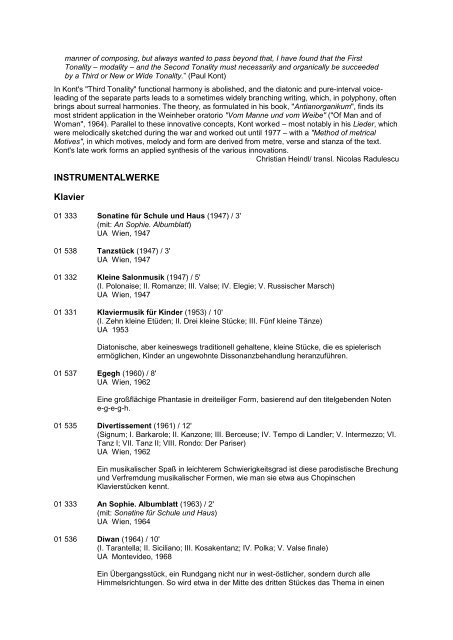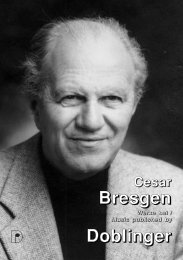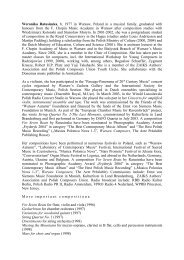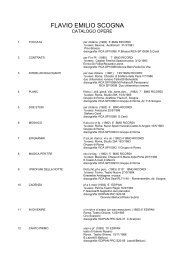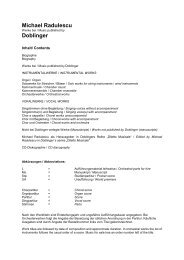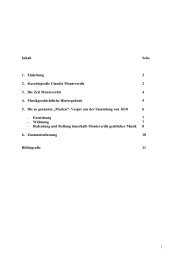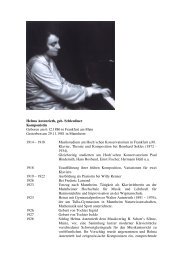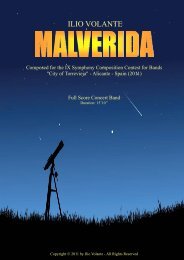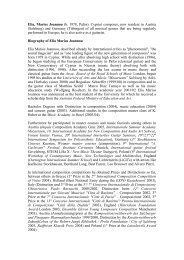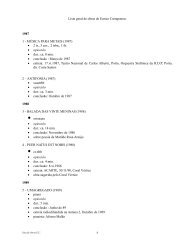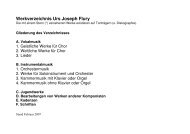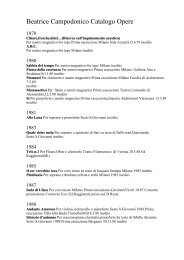Werke bei Doblinger - Klassika
Werke bei Doblinger - Klassika
Werke bei Doblinger - Klassika
Sie wollen auch ein ePaper? Erhöhen Sie die Reichweite Ihrer Titel.
YUMPU macht aus Druck-PDFs automatisch weboptimierte ePaper, die Google liebt.
manner of composing, but always wanted to pass beyond that, I have found that the First<br />
Tonality – modality – and the Second Tonality must necessarily and organically be succeeded<br />
by a Third or New or Wide Tonality.” (Paul Kont)<br />
In Kont's "Third Tonality" functional harmony is abolished, and the diatonic and pure-interval voiceleading<br />
of the separate parts leads to a sometimes widely branching writing, which, in polyphony, often<br />
brings about surreal harmonies. The theory, as formulated in his book, "Antianorganikum", finds its<br />
most strident application in the Weinheber oratorio "Vom Manne und vom Weibe" ("Of Man and of<br />
Woman", 1964). Parallel to these innovative concepts, Kont worked – most notably in his Lieder, which<br />
were melodically sketched during the war and worked out until 1977 – with a "Method of metrical<br />
Motives", in which motives, melody and form are derived from metre, verse and stanza of the text.<br />
Kont's late work forms an applied synthesis of the various innovations.<br />
Christian Heindl/ transl. Nicolas Radulescu<br />
INSTRUMENTALWERKE<br />
Klavier<br />
01 333 Sonatine für Schule und Haus (1947) / 3'<br />
(mit: An Sophie. Albumblatt)<br />
UA Wien, 1947<br />
01 538 Tanzstück (1947) / 3'<br />
UA Wien, 1947<br />
01 332 Kleine Salonmusik (1947) / 5'<br />
(I. Polonaise; II. Romanze; III. Valse; IV. Elegie; V. Russischer Marsch)<br />
UA Wien, 1947<br />
01 331 Klaviermusik für Kinder (1953) / 10'<br />
(I. Zehn kleine Etüden; II. Drei kleine Stücke; III. Fünf kleine Tänze)<br />
UA 1953<br />
Diatonische, aber keineswegs traditionell gehaltene, kleine Stücke, die es spielerisch<br />
ermöglichen, Kinder an ungewohnte Dissonanzbehandlung heranzuführen.<br />
01 537 Egegh (1960) / 8'<br />
UA Wien, 1962<br />
Eine großflächige Phantasie in dreiteiliger Form, basierend auf den titelgebenden Noten<br />
e-g-e-g-h.<br />
01 535 Divertissement (1961) / 12'<br />
(Signum; I. Barkarole; II. Kanzone; III. Berceuse; IV. Tempo di Landler; V. Intermezzo; VI.<br />
Tanz I; VII. Tanz II; VIII. Rondo: Der Pariser)<br />
UA Wien, 1962<br />
Ein musikalischer Spaß in leichterem Schwierigkeitsgrad ist diese parodistische Brechung<br />
und Verfremdung musikalischer Formen, wie man sie etwa aus Chopinschen<br />
Klavierstücken kennt.<br />
01 333 An Sophie. Albumblatt (1963) / 2'<br />
(mit: Sonatine für Schule und Haus)<br />
UA Wien, 1964<br />
01 536 Diwan (1964) / 10'<br />
(I. Tarantella; II. Siciliano; III. Kosakentanz; IV. Polka; V. Valse finale)<br />
UA Montevideo, 1968<br />
Ein Übergangsstück, ein Rundgang nicht nur in west-östlicher, sondern durch alle<br />
Himmelsrichtungen. So wird etwa in der Mitte des dritten Stückes das Thema in einen


